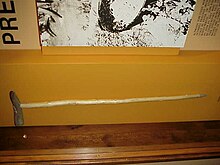
Back عصا الحفر Arabic Pal excavador Catalan Gravestok Danish Grabstock German Fosbastono Esperanto Luma (herramienta) Spanish Bâton fouisseur French 뒤지개 Korean Gravestokk NB Палка-копалка Russian


A digging stick, sometimes called a yam stick, is a wooden implement used primarily by subsistence-based cultures to dig out underground food such as roots and tubers, tilling the soil,[1] or burrowing animals and anthills. It is a term used in archaeology and anthropology to describe similar implements, which usually consists of little more than a sturdy stick which has been shaped or sharpened and sometimes hardened by being placed temporarily in a fire.[citation needed]
Fashioned with handles for pulling or pushing, it forms a prehistoric plough, and is also described as a type of hoe.[2] Digging sticks more than 170,000 years old, made of boxwood by Neanderthals, have been found in Italy.[3]
- ^ "Definition of digging stick". Dictionary.com. 2021. Retrieved 18 July 2021.
- ^ Encyclopædia Britannica, Inc. Retrieved March 26, 2015, from Britannica.com website: Digging stick
- ^ Biancamaria Aranguren; et al. (Feb 5, 2018). "Wooden tools and fire technology in the early Neanderthal site of Poggetti Vecchi (Italy)". PNAS. 115 (9): 2054–2059. Bibcode:2018PNAS..115.2054A. doi:10.1073/pnas.1716068115. PMC 5834685. PMID 29432163.